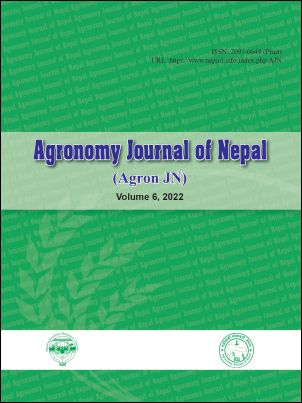Multi-year Prediction of Wheat Yield under the Changing Climatic Scenarios in Central-west Terai using DSSAT Crop Model
DOI:
https://doi.org/10.3126/ajn.v6i1.47919Keywords:
Agro-climatic indices, Central-west Terai, DSSAT 4.7 crop model, Multi-year prediction, Wheat yieldAbstract
The central-west Terai region is one of the major production domains of wheat in Nepal; however, its yield over the past three decades has been greatly affected by climate anomalies such as fluctuating temperatures, decreased solar radiation and rainfall. NASA-POWER derived weather data of Taulihawa in Kapilbastu (27.55° N, 83.667° E) district in central Terai for the past 32–33 years (1984/85 - 2017/18) were purposively selected and downloaded and validated with recorded weather data (1985/86, 1995/96, 2005/06 and 2015/16) of Department of Hydrology and Meteorology (DHM). The trend analysis for grain yield of wheat yield in Kapilvastu was drawn with the historical data of maximum and minimum temperatures and rainfall. Positive correlations between grain yields and minimum temperature and rainfall each showed an acceptable coefficient of determinations (R2). The Cropping system Model - Crop Environment Resource Synthesis (CSM-CERES)- Wheat model, embedded in Decision Support Systems for Agro-technology Transfer (DSSAT) ver 4.7 was used for multi-year predictions of wheat yields using both historically recorded and simulated climatic scenarios. Model simulated results closely agreed with the observed wheat yields recorded by the Ministry of Agriculture and Livestock Development (MoALD) in Nepal. The correlation coefficient of minimum temperature and wheat yield was 0.272 (p<0.05). The correlation between precipitation and observed and DSSAT simulated wheat yield were 0.379 (p<0.01). The multi-year predicted wheat yields using the historical weather data and by the use of the International Panel on Climate Change (IPCC, 2007) scenario embedded in DSSAT crop model showed that yield of wheat could be sustained with use of the current crop cultivars only for 2050 scenarios. Agro-climatic index, mainly temperature, was found to be more sensitive to wheat production in the Nepalese central-west Terai region. This study suggests for the development of new temperature and drought tolerant ready wheat cultivars to feed the increasingly growing Nepalese population.
Downloads
Downloads
Published
How to Cite
Issue
Section
License
Copyright (c) 2022 Agronomy Society of Nepal (ASoN)

This work is licensed under a Creative Commons Attribution-NonCommercial 4.0 International License.
ASON permits for free use, distribution and reproduction in any medium if the original work is properly cited and not used for commercial purposes.




